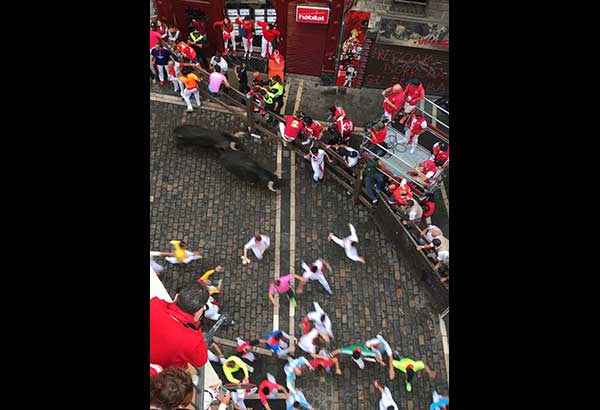Balconies, bold runners, and bulls

Runners run before the bulls, try their very best not to be gored by the horns, and live to brag about it. Fifty percent of the runners are first-time thrill-seekers.
Every year, a million people run with the bulls in Pamplona, in the region of Navarra, Spain. The feast of San Fermin, the co-patron saint — along with Saint Francis Xavier — and first bishop of Pamplona is a week-long celebration from July 6 to 14.
This tiny town explodes into fiesta fever, initiated at exactly 8 a.m. each morning with the encierro: six bulls and a few guiding steer are made to run a distance of 825 meters from their corral in Calle Santo Domingo, through the narrow streets of the old quarter, to the bull ring, where the traditional bullfight is held. Runners —brave perhaps, but more foolhardy, and absolutely drunk (50 percent of them are first-timers) — run ahead of the bulls, try to run faster than the 560-kilo bulls to avoid being gored by their horns, and live to brag about the experience. This takes three to four minutes.
Visitors, after partying the night before, must be in the area by 7 a.m. to be allowed to enter these privately owned balconies, which have been paid for way in advance: a safe and great vantage point, with light, crispy churros and thick, smooth hot chocolate served. Braver souls watch in front of or behind protective wooden boards on the crowded streets. Newspapers list the number of accidents that happen every year.
The pastores (bull “shepherds”), with their sticks, place themselves behind the running bulls and make sure the bulls run in the right direction. There are six bulls that take part in each evening’s bullfight, with two randomly-picked bulls to each of three matadors. Sadly, all six bulls are killed after each bullfight.
The history of Pamplona’s running of the bulls could have started in the 13th or 14th century. The first official celebration of San Fermines was in 1591. From a simple celebration then, it has evolved into eight days of music, processions, dancing, bullfights and fireworks enjoyed by children and adults, locals and visitors alike.
Attendees wear the traditional all-white clothes with a red handkerchief embroidered with their town’s coat-of-arms and a red sash.
On the last day (July 14), people sing the farewell song, as they look forward to next year’s celebration:
“Pobre de mi, pobre de mi, que se han acabado las fiestas de San Fermin.”
(Poor me, poor me, the San Fermin festivities have ended.)
The atmosphere is festive and contagious, whether one stays a week or just a day and a half. It is an absolute thrill to see and hear the unstoppable power of the bulls, the adrenaline-infused energy of the runners racing, the accidents — as men and animals mingle and make sharp corner turns at top speed. These short minutes can only live in the memory of those who have actually been to Pamplona.
* * *
Please tell me where to walk the talk: cecilialicauco2@gmail.com
Follow me on Instagram: cecilialicauco2



















